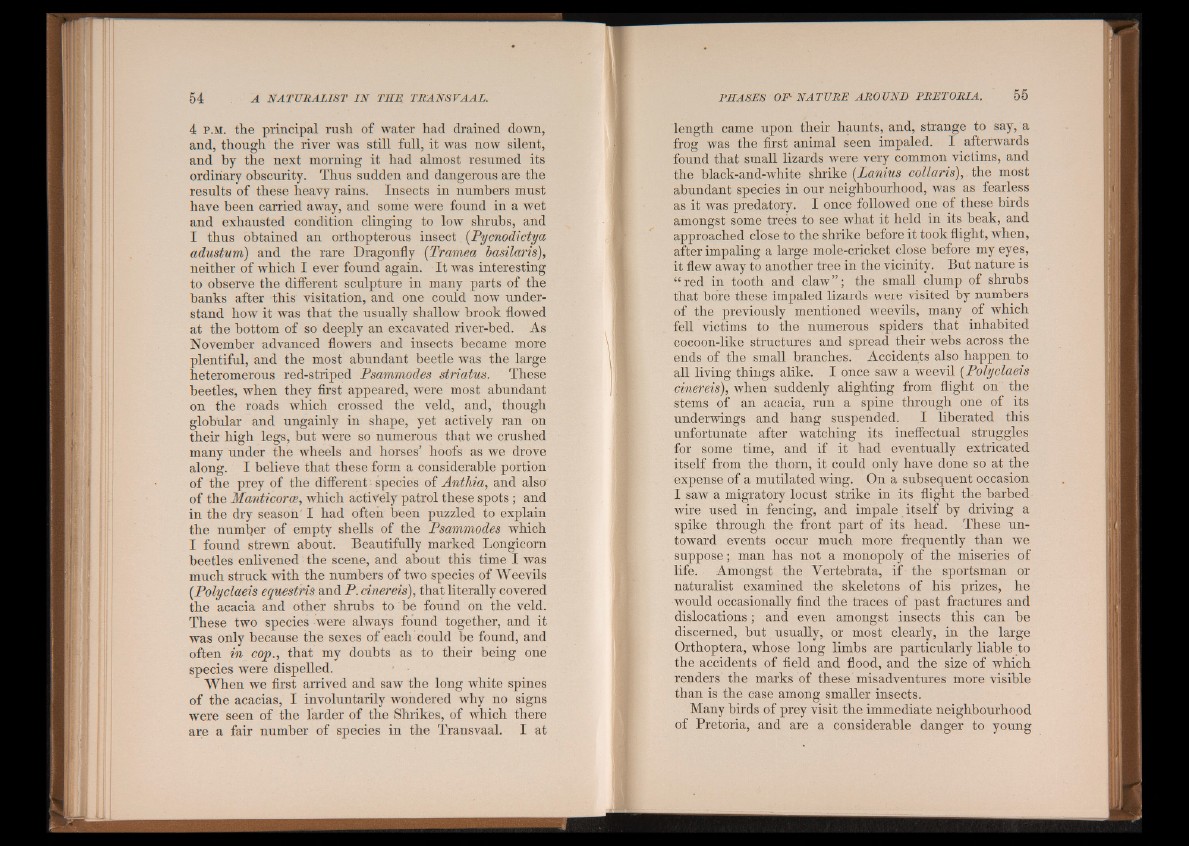
4 p.m. the principal rush of water had drained down,
and, though the river was still full, it was now silent,
and by the next morning it had almost resumed its
ordinary obscurity. Thus sudden and dangerous are the
results of these heavy rains. Insects in numbers must
have been carried away, and some were found in a wet
and exhausted condition clinging to low shrubs, and
I thus obtained an orthopterous insect. (Pycnodictya
adustvm) and the rare Dragonfly (Tramea basilaris),
neither of which I ever found again. It was interesting
to observe the different sculpture in many parts of the
banks after this visitation, and one could now understand
how it was that the usually shallow brook flowed
at the bottom of so deeply an excavated river-bed. As
November advanced flowers and insects became more
plentiful, and the most abundant beetle was the large
heteromerous red-striped Psammodes striatus. These
beetles, when they first appeared, were most abundant
on the roads which crossed the veld, and, though
globular and ungainly in shape, yet actively ran on
their high legs, but were so numerous that we crushed
many under the wheels and horses’ hoofs as we drove
along. I believe that these form a considerable portion
of the prey of the different; species of Anthia, and also
of the Manticorce, which actively patrol these spots ; and
in the dry season' I had often been puzzled to explain
the number of empty shells of the Psammodes which
I found strewn about. Beautifully marked Longicorn
beetles enlivened the scene, and about this time I was
much struck with the numbers of two species of Weevils
(Polyclaeis equestris and P. cinereis), that literally covered
the acacia and other shrubs to be found on the veld.
These two species were always found together, and it
was only because the sexes of each could be found, and
often in cop., that my doubts as to their being one
species were dispelled.
When we first arrived and saw the long white spines
of the acacias, I involuntarily wondered why no signs
were seen of the larder of the Shrikes, of which there
are a fair number of species in the Transvaal. I at
length came upon their haunts, and, strange to say, a
frog was the first animal seen impaled. I afterwards
found that small lizards were very common victims, and
the black-and-white shrike (Lanins collarts), the most
abundant species in our neighbourhood, was as fearless
as it was predatory. I once followed one of these birds
amongst some trees to see what it held in its beak, and
approached close to the shrike before it took flight, when,
after impaling a large mole-cricket close before my eyes,
it flew away to another tree in the vicinity. But nature is
“ red in tooth and claw” ; the small clump of shrubs
that bore these impaled lizards were visited by numbers
of the previously mentioned weevils, many of which
fell victims to the numerous spiders that inhabited
cocoon-like structures and spread their webs across the
ends of the small branches. Accidents also happen to
all living things alike. I once saw a weevil (Polyclaeis
cinereis), when suddenly alighting from flight on the
stems of an acacia, run a spine through one of its
underwings and hang suspended. I liberated this
unfortunate after watching its ineffectual struggles
for some time, and if it had eventually extricated
itself from the thorn, it could only have done so at the
expense of a mutilated wing. On a subsequent occasion
I saw a migratory locust strike in its flight the barbed
wire used in fencing, and impale itself by driving a
spike through the front part of its head. These untoward
events occur much more frequently than we
suppose; man has not a monopoly of the miseries of
life. Amongst the Yertebrata, if the sportsman or
naturalist examined the skeletons of his prizes, he
would occasionally find the traces of past fractures and
dislocations; and even amongst insects this can be
discerned, but usually, or most clearly, in the large
Orthoptera, whose long limbs are particularly liable to
the accidents of field and flood, and the size of which
renders the marks of these misadventures more visible
than is the case among smaller insects.
Many birds of prey visit the immediate neighbourhood
of Pretoria, and are a considerable danger to young